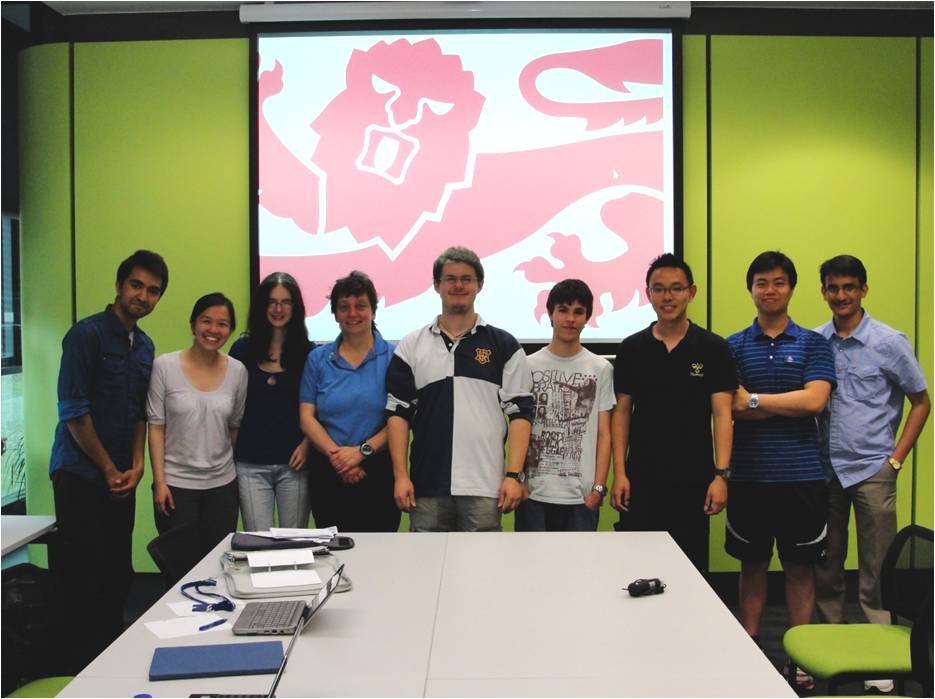Team:Newcastle
From 2010.igem.org
Swoodhouse (Talk | contribs) (→Project Description) |
Swoodhouse (Talk | contribs) (→Project Description) |
||
| Line 10: | Line 10: | ||
BacillaFilla, an engineered ''Bacillus subtilis'', aims to repair [[Team:Newcastle/problem|cracks in concrete]], which can cause catastrophic structural failure. BacillaFilla would be applied to structures by spraying onto their surface. | BacillaFilla, an engineered ''Bacillus subtilis'', aims to repair [[Team:Newcastle/problem|cracks in concrete]], which can cause catastrophic structural failure. BacillaFilla would be applied to structures by spraying onto their surface. | ||
| - | BacillaFilla swims deep into the | + | BacillaFilla swims deep into the cracks. Repair is effected by production of CaCO<sub>3</sub>, [[Team:Newcastle/Filamentous_Cells| filamentous ''Bacillus subtilis'' cells]] and [[Team:Newcastle/glue|levansucrose]]. [[Team:Newcastle/Urease| CaCO<sub>3</sub>]] expands at the same rate as concrete, making it the ideal filler. A filamentous cell mesh provides reinforcement. Levansucrose glues CaCO<sub>3</sub> and filamentous cells in place. |
''B. subtilis'' 168 sporulates, making it ideal for storage and transportation. The cells are naturally tolerant to concrete's high pH. We designed a swarming part for repairing ''B. subtilis'' 168's defective [[Team:Newcastle/Swarming|swrA and sfp]] genes and regaining motility. At the end of the crack the quorum sensing peptide [[Team:Newcastle/End_of_crack_%26_signalling_system|subtilin]] triggers a co-ordinated population response from a [[Team:Newcastle/End_of_crack_%26_signalling_system#2008Brick|subtilin-inducible promoter]]. Upregulating SR1 and rocF promotes arginine and urea production, increasing exogenous CaCO<sub>3</sub> deposition. Over-producing YneA induces the filamentous cell phenotype, while SacB converts extracellular sucrose to levansucrose glue. | ''B. subtilis'' 168 sporulates, making it ideal for storage and transportation. The cells are naturally tolerant to concrete's high pH. We designed a swarming part for repairing ''B. subtilis'' 168's defective [[Team:Newcastle/Swarming|swrA and sfp]] genes and regaining motility. At the end of the crack the quorum sensing peptide [[Team:Newcastle/End_of_crack_%26_signalling_system|subtilin]] triggers a co-ordinated population response from a [[Team:Newcastle/End_of_crack_%26_signalling_system#2008Brick|subtilin-inducible promoter]]. Upregulating SR1 and rocF promotes arginine and urea production, increasing exogenous CaCO<sub>3</sub> deposition. Over-producing YneA induces the filamentous cell phenotype, while SacB converts extracellular sucrose to levansucrose glue. | ||
Revision as of 19:23, 25 October 2010

| |||||||||||||
| |||||||||||||
BacillaFilla: Fixing cracks in Concrete
Project Description
BacillaFilla, an engineered Bacillus subtilis, aims to repair cracks in concrete, which can cause catastrophic structural failure. BacillaFilla would be applied to structures by spraying onto their surface.
BacillaFilla swims deep into the cracks. Repair is effected by production of CaCO3, filamentous Bacillus subtilis cells and levansucrose. CaCO3 expands at the same rate as concrete, making it the ideal filler. A filamentous cell mesh provides reinforcement. Levansucrose glues CaCO3 and filamentous cells in place. B. subtilis 168 sporulates, making it ideal for storage and transportation. The cells are naturally tolerant to concrete's high pH. We designed a swarming part for repairing B. subtilis 168's defective swrA and sfp genes and regaining motility. At the end of the crack the quorum sensing peptide subtilin triggers a co-ordinated population response from a subtilin-inducible promoter. Upregulating SR1 and rocF promotes arginine and urea production, increasing exogenous CaCO3 deposition. Over-producing YneA induces the filamentous cell phenotype, while SacB converts extracellular sucrose to levansucrose glue.
To protect the environment our project will also include a design for a kill switch.
 
|
 "
"
